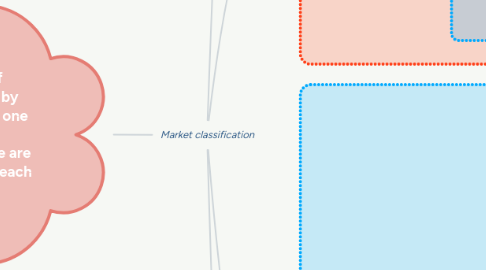
1. are the four basic models of market structure identified by economic science, for each one there are different price information processes. Here are the main characteristics of each model
2. Perfect competition
2.1. features
2.1.1. Homogeneity of the product, that is to say that the product offered by any seller is the same as that offered by all the rest.
2.1.2. No participant in the market, be it buyer or seller, can influence the price alone, since each one individually is so small in relation to the market as a whole that their actions cannot affect it.
2.1.3. Mobility of resources, which implies, for example, that workers can move from one region to another, raw materials are accessible to all on equal terms, companies can enter or leave the marke
2.1.4. Transparency of market information, such that consumers, companies and resource owners have perfect knowledge of the economic and technological data relevant to their activity
2.2. Given that the exigency of all the requirements is difficult to imagine a sector of economic activity that operates in a market of perfect competition. In perfect competition there is a basic or equilibrium normal price which is the one that corresponds to the equalization of the quantity supplied and the demand, a high price will promote production and discourage consumption, while a low price will discourage production and encourage production. consumption, therefore there must be a price for each commodity that makes the rate of production and consumption equal.
3. Monopoly
3.1. Monopoly is the market model opposed to perfect competition, that is, when the company is the only seller in the market because it is in situations such as the following:
3.1.1. Total control of the offer of a product.
3.1.2. Posibilidad de producir a un costo muy bajo el volumen suficiente para abastecer a todo el mercado a un precio rentable e inferior al de cualquier competidor.
3.1.3. Exclusive provision of patents inherent to the product
3.1.4. Exclusivity granted by the government to produce a product or provide a service, or, exercise of a monopoly directly by a state company
3.1.5. The logic of economic reasoning indicates that, in these cases, the monopoly provider, when it is a private company, will try to stay at the level of activity that optimizes its cost-volume-profit ratio. On the other hand, if it is the state, it can pursue different political, social and / or economic objectives.
4. Monopolistic competition
4.1. Monopolistic competition is an intermediate model between perfect competition and monopoly. This is the case in which most companies face competitors who market substitutes similar to their products, but differentials, due to which there is no homogeneity between the products of the different suppliers. "Each company has a monopoly on the sale of a single product, but the various brands are close substitutes."
4.2. features
4.2.1. Differentiated products that compete in the market, constituting similar substitutes for each other.
4.2.2. Large number of bidders, none of which is so important that their actions produce opposite reactions to their rivals.
4.2.3. Reaction of demand to changes in the price and identical cost structure for all bidding companies.
5. Oligopoly
5.1. The oligopoly model is a market in which a small number of suppliers operate who are highly dependent on each other. The reason that they are few lies in the entry barriers (heavy investment, patents, etc.). Their pricing decisions can be made independently or by making agreements between them. In reality, there is a great tendency to promote agreements giving rise to the so-called clubs of this or that branch in order to obtain greater profits, to ensure the position of each one, reduce uncertainty, to control the entry of new suppliers to the market
5.2. features
5.2.1. They are basically illegal.
5.2.2. They generate a strong tendency to not respect them (to betrayal), when it is convenient for one or another participant.
